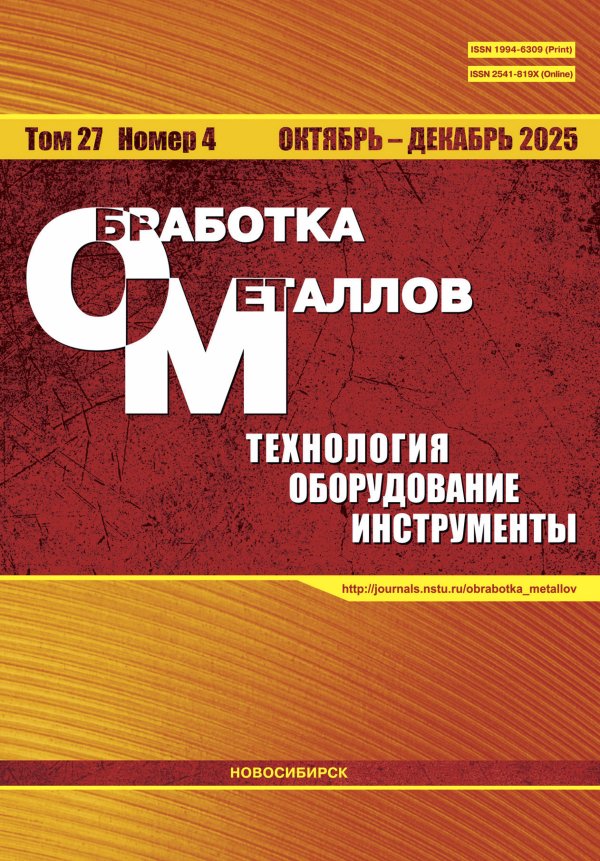Повышение качества изготовления изделий из жаропрочного никелевого сплава нового поколения с применением проволочно-вырезной электроэрозионной обработки
- Авторы: Шлыков Е.С.1, Абляз Т.Р.1, Блохин В.Б.1, Муратов К.Р.1
-
Учреждения:
- Выпуск: Том 27, № 1 (2025)
- Страницы: 34-47
- Раздел: ТЕХНОЛОГИЯ
- URL: https://bakhtiniada.ru/1994-6309/article/view/290286
- DOI: https://doi.org/10.17212/1994-6309-2025-27.1-34-47
- ID: 290286
Цитировать
Аннотация
Об авторах
Е. С. Шлыков
Email: Kruspert@mail.ru
ORCID iD: 0000-0001-8076-0509
канд. техн. наук, Пермский национальный исследовательский политехнический университет, Комсомольский проспект, 29, г. Пермь, 614990, Россия, Kruspert@mail.ru
Т. Р. Абляз
Email: lowrider11-13-11@mail.ru
ORCID iD: 0000-0001-6607-4692
канд. техн. наук, доцент, Пермский национальный исследовательский политехнический университет, Комсомольский проспект, 29, г. Пермь, 614990, Россия, lowrider11-13-11@mail.ru
В. Б. Блохин
Email: warkk98@mail.ru
ORCID iD: 0009-0009-2693-6580
Пермский национальный исследовательский политехнический университет, Комсомольский проспект, 29, г. Пермь, 614990, Россия, warkk98@mail.ru
К. Р. Муратов
Email: Karimur_80@mail.ru
ORCID iD: 0000-0001-7612-8025
доктор техн. наук, доцент, Пермский национальный исследовательский политехнический университет, Комсомольский проспект, 29, г. Пермь, 614990, Россия, Karimur_80@mail.ru
Список литературы
- Influence of the grade of hot work tool steels and its microstructural features on the durability of punches used in the closed die precision forging of valve forgings made of nickel-chrome steel / M. Hawryluk, M. Lachowicz, M. Zwierzchowski, M. Janik, Z. Gronostajski, J. Filipiak // Wear. – 2023. – Vol. 528–529. – doi: 10.1016/j.wear.2023.204963.
- Microstructure and abrasive wear behavior of a novel FeCrMoVC laser cladding alloy for high-performance tool steels / J. Zeisig, N. Schädlich, L. Giebeler, J. Sander, J. Eckert, U. Kühn, J. Hufenbach // Wear. – 2017. – Vol. 382–383. – P. 107–112. – doi: 10.1016/j.wear.2017.04.021.
- Mechanical properties and corrosion resistance of steel X210CrW12 after semi-solid processing and heat treatment / L. Rogal, J. Dutkiewicz, Z. Szklarz, H. Krawiec, M. Kot, S. Zimowski // Materials Characterization. – 2014. – Vol. 8823. – P. 100–110. – doi: 10.3329/jname.v7i2.5309.
- A comparative study on the erosion behavior and mechanism of chrome-coated 25Cr3Mo2WNiV steel and QPQ 25Cr3Mo2WNiV steel / C. Dou, K. Pan, C. Wang, S. Wei, C. Zhang, L. Xu, H. Cui, Y. Liang, J. Huang // Materials Today Communications. – 2024. – Vol. 41. – doi: 10.1016/j.mtcomm.2024.110820.
- Abbas M.N., Solomon D.G., Bahari Md. A review on current research trends in electrical discharge machining (EDM) // International Journal of Machine Tools and Manufacture. – 2007. – Vol. 47 (7). – P. 1214–1228. – doi: 10.1016/j.ijmachtools.2006.08.026.
- Liao Y.S., Chen S.T., Lin C.S. Development of a high precision tabletop versatile CNC wire-EDM for making intricate micro parts // Journal of Micromechanics and Microengineering. – 2005. – Vol. 15. – P. 245–253. – doi: 10.1088/0960-1317/15/2/001.
- Yoo H.K., Kwon W.T., Kang S. Development of a new electrode for micro-electrical discharge machining (EDM) using Ti(C, N)-based cermet // International Journal of Precision Engineering and Manufacturing. – 2014. – Vol. 15 (4). – P. 609–616. – doi: 10.1007/s12541-014-0378-x.
- Hoang K.T., Yang S.H. A study on the effect of different vibration-assisted methods in micro-WEDM // Journal of Materials Processing Technology. – 2013. – Vol. 213 (9). – P. 1616–1622. – doi: 10.1016/j.jmatprotec.2013.03.025.
- Hoang K.T., Yang S.H. A new approach for micro-WEDM control based on real-time estimation of material removal rate // International Journal of Precision Engineering and Manufacturing. – 2015. – Vol. 16 (2). – P. 241–246. – doi: 10.1007/s12541-015-0032-2.
- Debroy A., Chakraborty S. Non-conventional optimization techniques in optimizing non-traditional machining processes: a review // Management Science Letters. – 2013. – Vol. 4 (1). – P. 23–38. – doi: 10.5267/j.msl.2012.10.038.
- Swiercz R., Oniszczuk-Swiercz D., Chmielewski T. Multi-response optimization of electrical discharge machining using the desirability function // Micromachines. – 2019. – Vol. 10 (72). – doi: 10.3390/mi10010072.
- Swiercz R., Oniszczuk-Swiercz D. The effects of reduced graphene oxide flakes in the dielectric on electrical discharge machining // Nanomaterials. – 2019. – Vol. 9 (3). – doi: 10.3390/nano9030335.
- Chalisgaonkar R., Kumar J. Microstructural characteristics of pure titanium by WEDM // International Journal of Microstructure and Materials Properties. – 2014. – Vol. 9 (6). – P. 463–484. – doi: 10.1504/IJMMP.2014.067308.
- Study of micro structural material changes after WEDM based on TEM lamella analysis / K. Mouralova, R. Zahradnicek, L. Benes, T. Prokes, R. Hrdy, J. Fries // Metals. – 2020. – Vol. 10 (7). – P. 949. – doi: 10.3390/met10070949.
- Determination of residual stress distribution in high strength aluminum alloy after EDM / S. Mehmood, A. Sultan, N.A. Anjum, W. Anwar, Z. Butt // Advances in Science and Technology Research Journal. – 2017. – Vol. 11 (1). – P. 29–35. – doi: 10.12913/22998624/68729.
- Ablyaz T.R., Zhurin A.V., Shlykov E.S. Simulation of electrical discharge machining of dissimilar materials // ARPN Journal of Engineering and Applied Sciences. – 2018. – Vol. 13 (6). – P. 2173–2177.
- Discharge current effect on machining characteristics and mechanical properties of aluminum alloy 6061 workpiece produced by electric discharging machining process / C.-G. Kuo, C.-Y. Hsu, J.-H. Chen, P.-W. Lee // Advances in Mechanical Engineering. – 2017. – Vol. 9 (11). – P. 1–8. – doi: 10.1177/1687814017730756.
- Ghodsiyeh D., Golshan A.J., Shirvanehdeh A. Review on current research trends in wire electrical discharge machining (WEDM) // Indian Journal of Science and Technology. – 2013. – Vol. 6 (2). – P. 154–166. – doi: 10.17485/ijst/2013/v6i2.18.
- Experimental investigation of white layer thickness on EDM processed silicon steel using ANFIS approach / T. Muthuramalingam, D. Saravanakumar, L.G. Babu, H.P. Nguen, N.P. Vu // Silicon. – 2020. – Vol. 12. – P. 1905–1911. – doi: 10.1007/s12633-019-00287-2.
- The effect of power supply current on recast layer in S45C steel using wire EDM / H. Wijaya, S. Wahyudi, R. Soenoko, P.H. Setyarini, S. Yasid, F. Gapsari // IOP Conference Series Materials Science and Engineering. – 2019. – Vol. 494 (1). – doi: 10.1088/1757-899X/494/1/012102.
Дополнительные файлы







